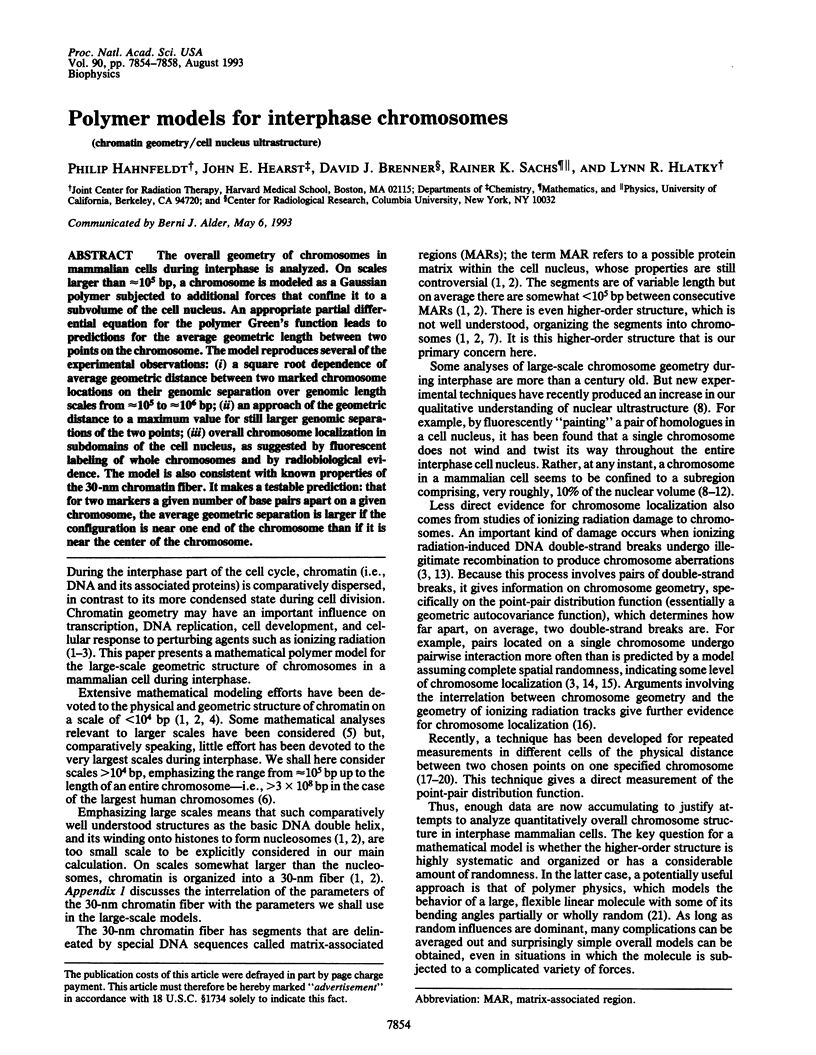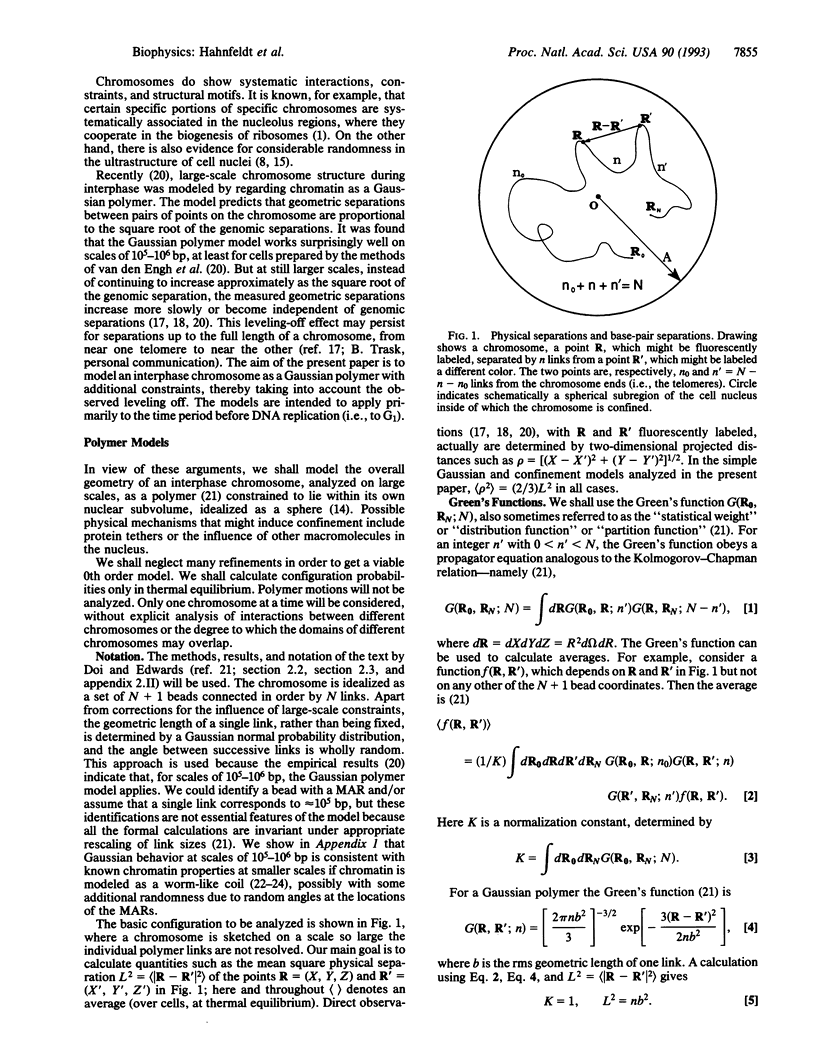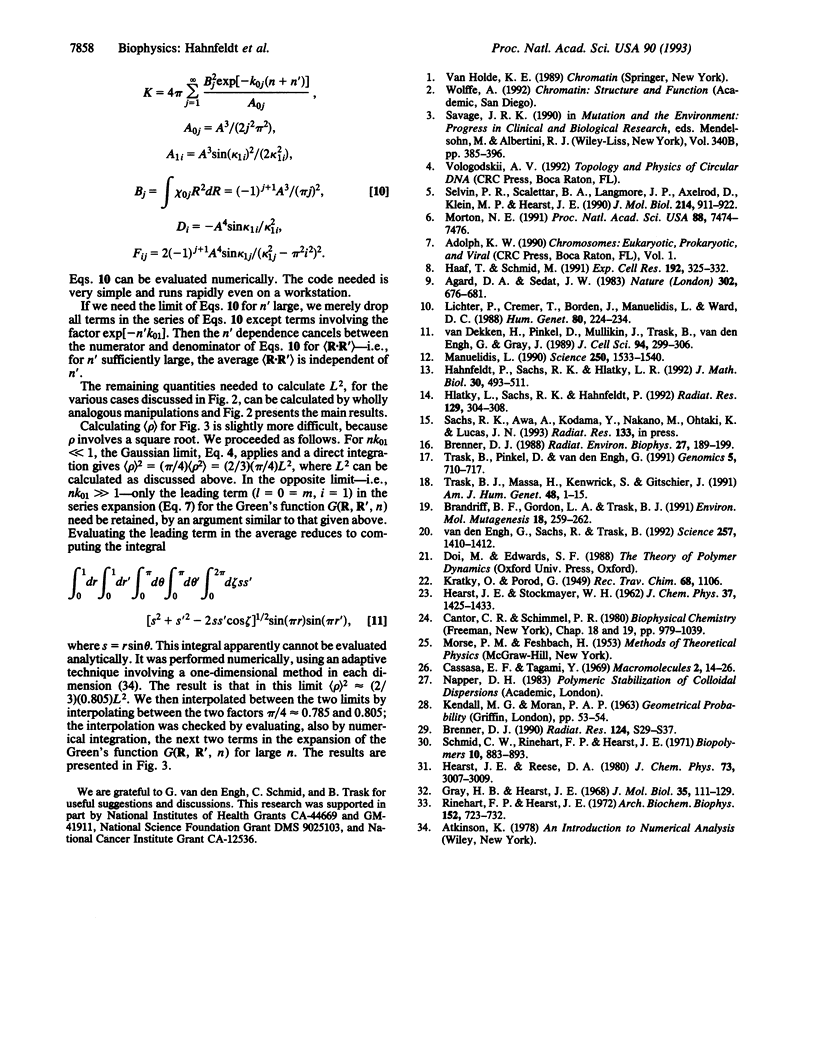Abstract
The overall geometry of chromosomes in mammalian cells during interphase is analyzed. On scales larger than approximately 10(5) bp, a chromosome is modeled as a Gaussian polymer subjected to additional forces that confine it to a subvolume of the cell nucleus. An appropriate partial differential equation for the polymer Green's function leads to predictions for the average geometric length between two points on the chromosome. The model reproduces several of the experimental observations: (i) a square root dependence of average geometric distance between two marked chromosome locations on their genomic separation over genomic length scales from approximately 10(5) to approximately 10(6) bp; (ii) an approach of the geometric distance to a maximum value for still larger genomic separations of the two points; (iii) overall chromosome localization in subdomains of the cell nucleus, as suggested by fluorescent labeling of whole chromosomes and by radiobiological evidence. The model is also consistent with known properties of the 30-nm chromatin fiber. It makes a testable prediction: that for two markers a given number of base pairs apart on a given chromosome, the average geometric separation is larger if the configuration is near one end of the chromosome than if it is near the center of the chromosome.
Full text
PDF




Selected References
These references are in PubMed. This may not be the complete list of references from this article.
- Agard D. A., Sedat J. W. Three-dimensional architecture of a polytene nucleus. Nature. 1983 Apr 21;302(5910):676–681. doi: 10.1038/302676a0. [DOI] [PubMed] [Google Scholar]
- Brandriff B. F., Gordon L. A., Trask B. J. DNA sequence mapping by fluorescence in situ hybridization. Environ Mol Mutagen. 1991;18(4):259–262. doi: 10.1002/em.2850180410. [DOI] [PubMed] [Google Scholar]
- Brenner D. J. On the probability of interaction between elementary radiation-induced chromosomal injuries. Radiat Environ Biophys. 1988;27(3):189–199. doi: 10.1007/BF01210836. [DOI] [PubMed] [Google Scholar]
- Brenner D. J. Track structure, lesion development, and cell survival. Radiat Res. 1990 Oct;124(1 Suppl):S29–S37. [PubMed] [Google Scholar]
- Gray H. B., Jr, Hearst J. E. Flexibility of native DNA from the sedimentation behavior as a function of molecular weight and temperature. J Mol Biol. 1968 Jul 14;35(1):111–129. doi: 10.1016/s0022-2836(68)80041-5. [DOI] [PubMed] [Google Scholar]
- Haaf T., Schmid M. Chromosome topology in mammalian interphase nuclei. Exp Cell Res. 1991 Feb;192(2):325–332. doi: 10.1016/0014-4827(91)90048-y. [DOI] [PubMed] [Google Scholar]
- Hahnfeldt P., Sachs R. K., Hlatky L. R. Evolution of DNA damage in irradiated cells. J Math Biol. 1992;30(5):493–511. doi: 10.1007/BF00160533. [DOI] [PubMed] [Google Scholar]
- Hlatky L. R., Sachs R. K., Hahnfeldt P. The ratio of dicentrics to centric rings produced in human lymphocytes by acute low-LET radiation. Radiat Res. 1992 Mar;129(3):304–308. [PubMed] [Google Scholar]
- Lichter P., Cremer T., Borden J., Manuelidis L., Ward D. C. Delineation of individual human chromosomes in metaphase and interphase cells by in situ suppression hybridization using recombinant DNA libraries. Hum Genet. 1988 Nov;80(3):224–234. doi: 10.1007/BF01790090. [DOI] [PubMed] [Google Scholar]
- Manuelidis L. A view of interphase chromosomes. Science. 1990 Dec 14;250(4987):1533–1540. doi: 10.1126/science.2274784. [DOI] [PubMed] [Google Scholar]
- Morton N. E. Parameters of the human genome. Proc Natl Acad Sci U S A. 1991 Sep 1;88(17):7474–7476. doi: 10.1073/pnas.88.17.7474. [DOI] [PMC free article] [PubMed] [Google Scholar]
- Rinehart F. P., Hearst J. E. The ionic strength dependence of the coil dimensions of viral DNA in NH 4 AC solutions. Arch Biochem Biophys. 1972 Oct;152(2):723–732. doi: 10.1016/0003-9861(72)90268-8. [DOI] [PubMed] [Google Scholar]
- Schmid C. W., Rinehart F. P., Hearst J. E. Statistical length of DNA from light scattering. Biopolymers. 1971;10(5):883–893. doi: 10.1002/bip.360100511. [DOI] [PubMed] [Google Scholar]
- Selvin P. R., Scalettar B. A., Langmore J. P., Axelrod D., Klein M. P., Hearst J. E. A polarized photobleaching study of chromatin reorientation in intact nuclei. J Mol Biol. 1990 Aug 20;214(4):911–922. doi: 10.1016/0022-2836(90)90345-M. [DOI] [PubMed] [Google Scholar]
- Trask B. J., Massa H., Kenwrick S., Gitschier J. Mapping of human chromosome Xq28 by two-color fluorescence in situ hybridization of DNA sequences to interphase cell nuclei. Am J Hum Genet. 1991 Jan;48(1):1–15. [PMC free article] [PubMed] [Google Scholar]
- Trask B., Pinkel D., van den Engh G. The proximity of DNA sequences in interphase cell nuclei is correlated to genomic distance and permits ordering of cosmids spanning 250 kilobase pairs. Genomics. 1989 Nov;5(4):710–717. doi: 10.1016/0888-7543(89)90112-2. [DOI] [PubMed] [Google Scholar]
- van Dekken H., Pinkel D., Mullikin J., Trask B., van den Engh G., Gray J. Three-dimensional analysis of the organization of human chromosome domains in human and human-hamster hybrid interphase nuclei. J Cell Sci. 1989 Oct;94(Pt 2):299–306. doi: 10.1242/jcs.94.2.299. [DOI] [PubMed] [Google Scholar]
- van den Engh G., Sachs R., Trask B. J. Estimating genomic distance from DNA sequence location in cell nuclei by a random walk model. Science. 1992 Sep 4;257(5075):1410–1412. doi: 10.1126/science.1388286. [DOI] [PubMed] [Google Scholar]


